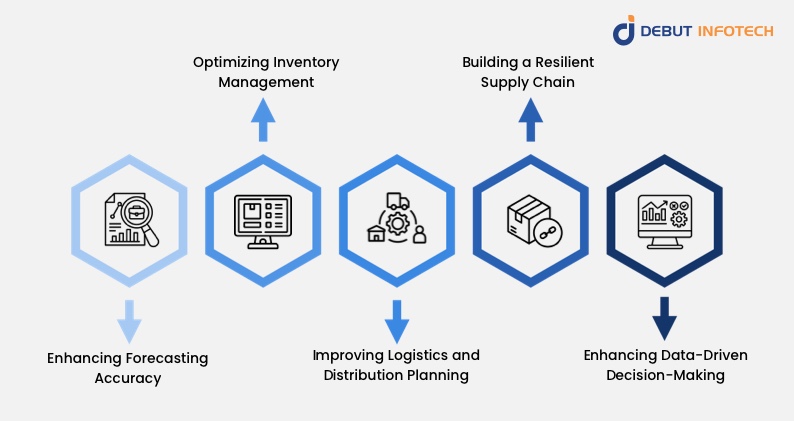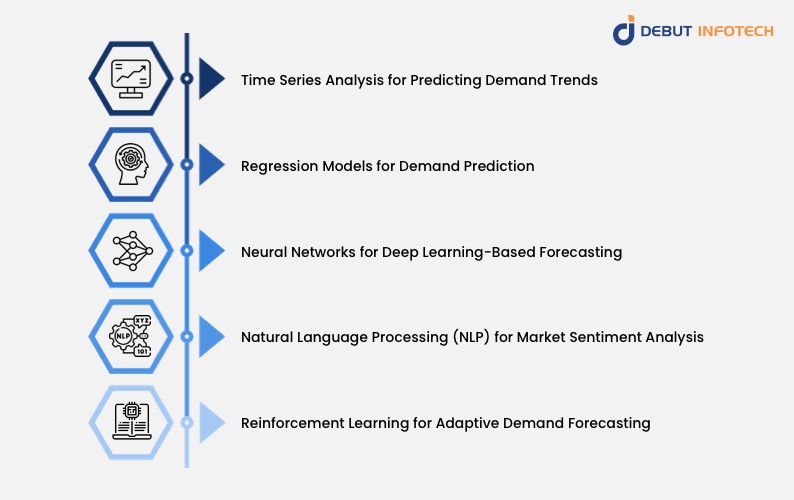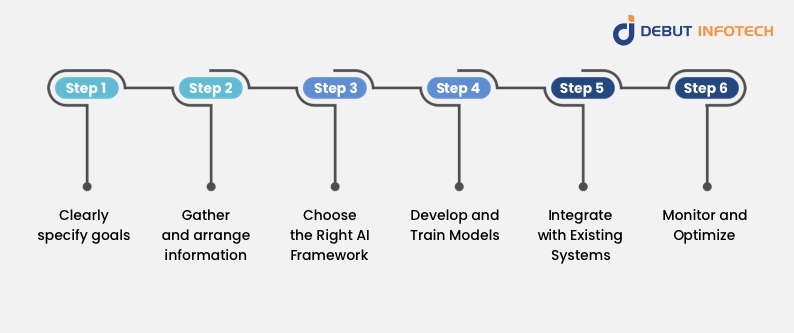Table of Contents
Home / Blog / AI/ML
AI-Powered Demand Forecasting: Optimize Supply Chains
February 5, 2025

February 5, 2025
AI in demand forecasting has changed how companies forecast possible shortages, inventory needs, and market trends. Because of fast-changing customer behaviour, worldwide supply chain interruptions, and economic swings, traditional forecasting techniques occasionally struggle with accuracy. AI and ML, on the other hand, are now very important for making predictions more accurate, cutting down on waste, and overall better supply chain management. Demand forecasting methods based on artificial intelligence are helping businesses in many different sectors maximize their operations and increase profitability.
Demand forecasting using artificial intelligence helps companies examine past data, spot trends, and make real-time inventory management changes. AI-driven demand forecasting automation helps manufacturing, retail, healthcare, and e-commerce businesses maximize income, stay ahead of consumer trends, and minimize shortages. Using AI tools, AI algorithms, and demand planning AI software together makes it possible to make accurate predictions, which helps businesses meet customer needs while keeping costs low.
Smarter Forecasts, Better Decisions
Harness the power of AI to predict demand with accuracy, reduce waste, and optimize inventory like never before. Stay ahead of market trends with data-driven insights.
How AI is Used to Forecast Shortages
Now, let’s see how AI is used to forecast shortages. Without enough supplies, supply chains can break down in major ways, which can cost money and leave customers unsatisfied. AI for demand forecasting enables companies to predict possible supply chain problems before they occur, guiding their actions. AI uses many organized and unstructured data, like sales records, weather patterns, economic indicators, and even social media trends, to predict shortages.
Advanced artificial intelligence algorithms and machine learning methods are used in demand forecasting models to identify early warning signals of supply chain disturbance. Using artificial intelligence in demand forecasting will help businesses modify procurement plans, maximize manufacturing schedules, and stop stockouts. AI-driven analytics can also recommend substitute materials or suppliers, lessening reliance on one source and guaranteeing business continuity even in a supply chain crisis.
AI for Demand Forecasting in Supply Chain Management
The use of AI within supply chain management has changed how companies deal with supply and demand variations. Using artificial intelligence technology, companies can foresee possible shortages, maximize inventory, and simplify logistics, increasing their productivity and saving costs.

Enhancing Forecasting Accuracy
Seasonality, economic conditions, or outside events can all cause unanticipated demand changes that traditional forecasting techniques find challenging. AI-based demand forecasting uses AI algorithms and machine learning (ML) to sift through massive datasets in search of previously unseen trends. AI-powered models always learn from past patterns, current sales data, and outside factors like weather patterns, geopolitical events, or supplier success. This makes it possible for them to predict future demand accurately.
Optimizing Inventory Management
Demand planning artificial intelligence software helps businesses keep ideal stock levels by forecasting the exact amount of products needed. Artificial intelligence demand forecasting eliminates the possibility of money being tied up due to overstocking or missed revenues and unhappy customers due to understocking by maintaining a balance between the two. Demand forecasting automation for ecommerce is becoming increasingly important to manufacturers, retailers, and e-commerce companies to keep seamless operations and avoid inefficiencies.
Improving Logistics and Distribution Planning
Optimizing logistics depends much on AI in demand forecasting since it helps to improve distribution planning. Real-time transportation data and warehouse conditions allow AI-driven solutions to suggest the most effective paths, delivery plans, and lines of action. This lowers lead times, cuts travel expenses, and improves general supply chain performance. Companies using AI for forecasting can also dynamically change their logistics strategies depending on changing customer demand and unanticipated interruptions.
Building a Resilient Supply Chain
Using AI for supply chain management with shortages enables businesses to identify vulnerabilities within their supply networks and take proactive measures. Using supplier dependability, production capacity, and market trends, AI-driven risk assessment models indicate possible supply chain interruptions before they start. Furthermore, AI forecast shortage tools might suggest different suppliers or reallocation techniques to reduce risks, guaranteeing business continuity even under uncertain market situations.
Enhancing Data-Driven Decision-Making
AI development services give supply chain managers practical insights that enable them to make informed decisions. By helping companies incorporate AI solutions catered to their particular supply chain issues, AI consulting firms enhance agility and responsiveness. AI demand planning helps businesses better match their procurement plans, change their manufacturing schedules, and maximize their distribution networks to fulfill demand adequately.
AI Demand Forecasting for eCommerce
Demand forecasting automation for e-commerce has greatly changed how online stores project customer demand, maximize inventory, and change price policies. Unlike conventional demand forecasting models based on past sales data and simple trend analysis, AI for demand forecasting in eCommerce uses powerful machine learning (ML) models and AI algorithms to offer real-time, very precise forecasts. These AI-driven insights enable companies to keep appropriate inventory levels, lower running expenses, and enhance client experiences that they can sustain.
In eCommerce, some main advantages of artificial intelligence (AI) demand forecasting are:
Enhancing Personalized Shopping Experiences
Demand forecasting AI does more than just inventory control. It enables stores to customize shopping experiences for particular consumers. AI can suggest items that fit a consumer’s tastes by examining browsing history, past purchases, and customer demographics. This generally raises consumer satisfaction, enhances engagement, and drives sales. Many top eCommerce systems include AI development services in their recommendation engines to improve personalization and stimulate income expansion.
Dynamic Pricing Strategies for Maximum Profitability
Dynamic pricing strategies driven by artificial intelligence use real-time data to change product prices depending on consumer buying behaviour, rival pricing, and demand variations. Using AI for forecasting, companies can establish ideal pricing strategies, maximizing income while retaining client satisfaction. Through constant market analysis, artificial intelligence solutions help eCommerce stores remain competitive and take advantage of times of maximum demand.
Fraud Detection and Prevention
Fake orders and payment fraud are among the e-commerce industry’s vulnerabilities. Using AI algorithms, artificial intelligence-powered fraud detection systems track odd buying trends, flag questionable transactions, and stop income loss. AI development companies build fraud detection tools using enormous volumes of transaction data to find anomalies in real-time. Incorporating AI data security solutions helps eCommerce systems safeguard their consumers and reduce financial risk.
Supply Chain Optimization for Faster Deliveries
Demand forecasting AI is additionally very important for supply chain operations optimization. Artificial intelligence development companies increase responsiveness and efficiency by including predictive analytics and artificial intelligence technologies in supply chain management systems. By analyzing data, AI helps companies improve order fulfilment, decrease delivery times, and choose the best locations for warehouses and shipping routes. AI forecast shortage techniques let e-commerce stores proactively modify their supply chains to prevent interruptions brought on by supplier delays or demand spikes.
Optimizing Inventory Management
Ensuring the correct products are on hand when consumers need them presents one of the toughest obstacles facing e-commerce, by projecting which products will be in great demand and when artificial intelligence demand forecasting helps stores balance supply and demand. This reduces the possibility of overstocking—which causes unneeded storage costs—and stockouts—which cause missed revenues. Through demand forecasting automation for eCommerce, AI-driven algorithms evaluate consumer behaviour, seasonal trends, and outside variables, including economic changes or social media impact, to generate exact inventory recommendations.
By incorporating AI forecast shortages strategies into their operations, eCommerce businesses can achieve greater agility and profitability.
The Role of AI Development Companies in Demand Forecasting
AI consulting firms and AI development companies play a pivotal role in implementing AI for forecasting solutions. Companies wishing to include demand forecasting solutions driven by artificial intelligence could hire AI developers to create customized models that fit their particular requirements. These professionals create cutting-edge AI applications using artificial intelligence tools that simplify demand planning procedures.
Through real-time information and automated decision-making, AI copilot development and AI chatbot development services improve demand forecasting even more. AI agents help companies keep ahead of industry trends by handling enormous volumes and providing useful advice.
Demand Forecasting Machine Learning Techniques
Machine learning plays a crucial role in demand forecasting. Some of the most commonly used demand forecasting machine learning techniques include:

Time Series Analysis for Predicting Demand Trends
Among the most basic methods in AI demand forecasting is time series analysis. Analyzing past sales data is part of it to spot trends and patterns that might guide future demand. Processing vast amounts of data, AI algorithm systems identify seasonality, cyclic fluctuations, and abrupt demand spikes. Time series methods, including ARIMA (AutoRegressive Integrated Moving Average) and Exponential Smoothing, are used by companies to generate quite accurate demand forecasts. Retail, e-commerce, and hospitality are just a few of the sectors where demand varies depending on time-based variables, so this approach is especially helpful there.
Regression Models for Demand Prediction
Regression models are widely used in demand forecasting to identify relationships between different variables that influence demand. These models analyze factors such as product pricing, promotional campaigns, economic conditions, weather patterns, and consumer behaviour. Multiple linear regression (MLR) and decision tree regression are two common approaches that help businesses understand how different variables impact sales performance. By integrating AI development services, companies can refine regression models to produce dynamic, real-time forecasts that adjust based on new market data.
Neural Networks for Deep Learning-Based Forecasting
By simulating human brain activity to process challenging datasets, neural networks provide a more advanced artificial intelligence demand forecasting method. Deep learning models can find complex demand variations that conventional forecasting techniques can overlook. Businesses in the fashion, consumer electronics, and e-commerce sectors benefit greatly from the sequential data analysis capabilities of Recurrent Neural Networks (RNNs) and Long Short-Term Memory (LSTM) networks. Over time, these AI-powered forecasting systems learn from fresh data to increase accuracy constantly.
Natural Language Processing (NLP) for Market Sentiment Analysis
Natural language processing (NLP) is a potent artificial intelligence-driven method for extracting insights from unstructured data sources such as consumer reviews, social media posts, and online surveys. NLP models enable companies to better control their AI demand planning techniques by examining consumer feedback. Demand forecasting also depends on the AI chatbot development since it gathers real-time client feedback and identifies possible changes in buying patterns. Retailers and e-commerce platforms use NLP-enhanced AI tools to forecast demand for particular products, therefore guaranteeing timely supply replacement.
Reinforcement Learning for Adaptive Demand Forecasting
An advanced artificial intelligence demand forecasting method called reinforcement learning (RL) lets AI agents learn and grow in their capacity for forecasting through constant feedback. Unlike static models, reinforcement learning-based AI algorithms are perfect for dynamic sectors like logistics and supply chain management since they alter in real time. RL models help artificial intelligence-driven demand forecasting automation for eCommerce by automatically changing inventory and pricing policies depending on demand swings. RL approaches are progressively used in AI copilot development to produce intelligent forecasting assistants that maximize corporate operations.
These AI-powered forecasting techniques enable businesses to make data-driven decisions and enhance overall operational efficiency.
AI Data Security in Demand Forecasting
Since demand forecasting increasingly depends on artificial intelligence, AI data security becomes critical. Maintaining confidence and regulatory compliance depends on keeping critical business and customer data safe from cyberattacks. Strong security mechanisms, including encryption, access restrictions, and anomaly detection, are included in AI development services to protect demand forecasting models.
Cyber databases and AI-driven security solutions track data integrity, ensuring that demand forecasting automation for eCommerce and other sectors stays safe and dependable. By identifying suspicious behaviour and preventing data breaches, AI-powered fraud detection systems improve data security even more.
Implementing AI Demand Forecasting Solutions
Companies should use a methodical approach if they are to apply AI-based demand forecasting systems effectively:

- Clearly specify goals: List the main problems and objectives AI demand forecasting will help to solve.
- Gather and arrange information: Compile pertinent historical and real-time data that is complemented and accurate.
- Choose the Right AI Framework: Choose AI development companies or consultants with demand forecasting AI solution experience.
- Develop and Train Models: Hire AI developers to build and train ML models using advanced AI algorithms.
- Integrate with Existing Systems: Guarantee flawless integration with ERP, inventory, and supply chain management.
- Monitor and Optimize: Use measurements and real-time feedback to fine-tune real-time AI models.
By following these steps, businesses can harness the power of AI for demand forecasting and gain a competitive edge in their respective industries.
Future of AI in Supply Chain Forecasting
As AI continues to evolve, AI development companies focus on creating more advanced AI agents that incorporate LLM models and AI copilot development for intelligent supply chain decision-making. Businesses that embrace AI tools for supply chain management will gain a competitive edge, as AI-driven automation ensures accurate forecasting, reduces costs, and enhances operational efficiency.
By implementing AI for demand forecasting, companies can successfully navigate the complexities of modern supply chains, ensuring accurate databases and well-informed planning that drive sustainable growth.
Questions About AI in Demand Forecasting?
Discover how AI can enhance your demand forecasting, minimize stock issues, and optimize your supply chain. Our experts are here to help!
Conclusion
AI in demand forecasting is revolutionizing how businesses predict and manage market demand. By leveraging AI for forecasting, companies can achieve greater accuracy, optimize supply chains, and prevent shortages. AI demand forecasting solutions, powered by advanced AI algorithms and ML techniques, enable businesses to make data-driven decisions, reduce operational risks, and enhance customer satisfaction.
From eCommerce to supply chain management, AI-based demand forecasting is proving to be a game-changer. Companies that invest in AI development services, AI chatbot development, and AI copilot development are well-positioned to navigate market uncertainties and achieve long-term success. With AI consulting firms and AI development companies providing cutting-edge solutions, the future of demand forecasting automation for eCommerce and other industries looks promising.
By embracing AI-driven demand forecasting, businesses can improve efficiency and stay ahead of their competition in an increasingly data-driven world.
Frequently Asked Questions
AI enhances demand forecasting accuracy by analyzing vast amounts of real-time historical data, market trends, and external factors. Machine learning models identify patterns and adjust predictions dynamically, reducing forecasting errors and improving inventory management.
AI detects potential shortages by monitoring supply chain disruptions, demand fluctuations, and production constraints. Advanced AI algorithms analyze external variables like weather, economic shifts, and supplier performance to provide proactive shortage predictions.
AI-driven demand forecasting automates inventory replenishment, prevents overstocking or stockouts, and enhances customer satisfaction. It enables businesses to optimize pricing, reduce waste, and improve operational efficiency with real-time insights.
AI in demand forecasting relies on machine learning (ML), deep learning, natural language processing (NLP), and large language models (LLMs). These technologies process structured and unstructured data, refine predictions, and support decision-making.
Yes, AI-powered systems analyze supply chain risks, suggest alternative suppliers, and optimize logistics to mitigate shortages. AI-driven automation enhances resilience by predicting disruptions and recommending contingency plans.
AI development companies offer AI consulting services, custom AI solutions, and demand planning artificial intelligence software. They help businesses integrate AI tools into existing systems, ensuring scalability, security, and seamless operation.
Yes, AI demand forecasting solutions are available for businesses of all sizes. Cloud-based AI tools and demand forecasting automation make it accessible for small businesses to optimize inventory, improve cash flow, and enhance customer service without large investments.
Yes, by improving forecast accuracy, AI reduces excess inventory, prevents stock shortages, minimizes holding costs, and optimizes logistics, ultimately cutting overall supply chain expenses.
Talk With Our Expert
Our Latest Insights
USA
2102 Linden LN, Palatine, IL 60067
+1-703-537-5009
[email protected]
UK
Debut Infotech Pvt Ltd
7 Pound Close, Yarnton, Oxfordshire, OX51QG
+44-770-304-0079
[email protected]
Canada
Debut Infotech Pvt Ltd
326 Parkvale Drive, Kitchener, ON N2R1Y7
+1-703-537-5009
[email protected]
INDIA
Debut Infotech Pvt Ltd
C-204, Ground floor, Industrial Area Phase 8B, Mohali, PB 160055
9888402396
[email protected]




Leave a Comment